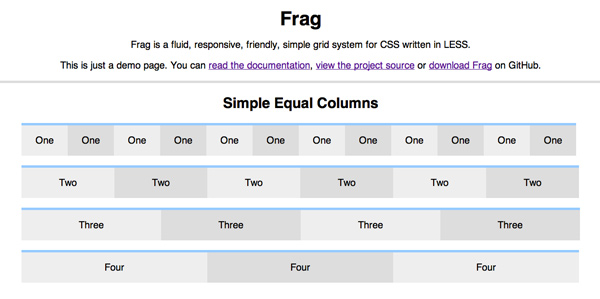Why I Built Another CSS Grid
A couple of months ago, I decided to set about building a CSS grid system. I realise that I’ve entered a wildly bloated landscape here (you can’t move on the web for fancy new grid systems) but I had my reasons. I’d like to talk about why I built a grid system, and why (maybe) you should too.
My Problem
When my website went through its last rebuild, I realised that there was no way I could get by without some kind of grid. I wrote down a couple of requirements that I had:
- Fluidity - fixed-width layouts don’t do it for me.
- Responsivity - I don’t think it’s sensible to not provide at least a basic mobile-optimised view.
- IE7 support - a contentious one, I know, but I want at least a sensible looking page in older browsers.
With these requirements in mind, I decided to have a look at what was available. It didn’t take me long to realise that there are a million projects out there; a split between massively overcomplicated frameworks which try to solve every problem in the world and neat little micro-grids. While there were some really great libraries, none of them felt quite right for me – I’m hard to please.
Building
What surprised me is how quickly I ended up with a good working (IE 6+) prototype. Not only was it fast, but I had a lot of fun!
After a couple of hours spent tweaking and testing, I ended up with Frag. It’s not perfect, it’s not extremely feature-rich, but it does exactly the job I need it to do.

So Why Build Your Own?
I’m not advocating rolling your own in every situation, but there are a lot of benefits to spending a little time on your own solution to a problem:
- Learning
- I learnt a lot in the process of building Frag, particularly about CSS3 media queries. I don’t know about you, but I love to learn; throwing yourself into a problem is nearly always the best way to do this.
- Understanding
- The benefit of understanding the code you’re using inside out is massive. There’s nearly always an overhead when learning how to use third-party software. Sometimes, for simple things, this is avoidable by building it yourself.
- Giving Back
- Whether or not you expect anyone to use it, you can get a pretty good feeling from releasing open-source software. You might help someone out with a project or with learning a new technology. This is awesome!
If you do end up building something great as a result of this post, I’d be really interested to take a look: tweet it at me!
And if you don’t fancy building your own grid system, you could always use Frag 😉